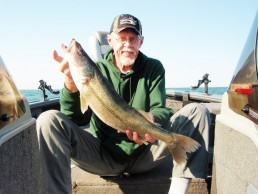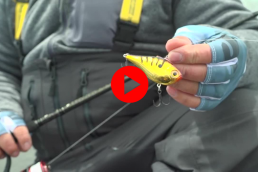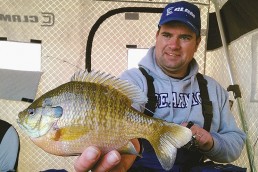Let’s Get Right to the Point
SHARE THIS POST
When my friends and I go fishing, we try to put as many odds in our favor as we possibly can. Being that one of our primary objectives is to be successful in hooking and landing fish, we plan our forays to take advantage of prevailing wind and weather conditions and the peak feeding periods of whichever species we are targeting. Every possible attempt is made to “read the signs,” adapt to the conditions and establish a pattern, which will result in our hauling a few fish over the side of the boat. So let’s get right to the point!
So, where to find the fish
One of the rock-solid rules that we have espoused over the decades is that fish like to hang around points. Many years ago, I heard a renowned bass fisherman state that if a fisherman did nothing else but fish around points, he would always catch some fish. Over the decades, that knowledge has helped us increase our catches time and time again.
What is it about points that draws fish to them like iron shavings are drawn to a magnet? One answer is that, for most freshwater species, environment influences the way that they live. For one species in particular, the walleye, the abundance of food or the lack of it influences its behavior during every season of the year. Since its preferred food groups spend much of their time on, over or near points, this species commonly uses such structure as its perennial feeding grounds. To survive, fish must find food, and they will seek it where it is most available.
What kind of water
Contrary to conventional wisdom, walleyes do not spend most of their time in clear water. Windswept water off the end of a point is typically murky, if not downright dirty, and it is here where ol’ marble-eyes begins its quest for some chow. If there are suspended baitfish off a rocky point, you can bet your trolling motor that there are walleyes down below, and that they are feeding on the smaller fish. They will remain there, suspended, as long as the baitfish remain in place.
Now what do I do
If the action slows down or stops, run your boat to the other side of the point. Try trolling at the same depth, the same speed and with the same setup you used when they were biting. If this does not work, try anchoring over the school. If you have found it on your Lowrance unit, do some vertical jigging. Try some Northland jigs, silver or hammered brass spoons tipped with half a nightcrawler or cut minnows., or the always effective, but often overlooked Rapala Jiggin’ Rap, which is dynamite in warm water. Troll over the ends and both sides of the point with medium- or deep-running Rapala Husky Jerks. Fancast the end of the point with crankbaits such as the Rapala Rattlin’ Rap, Storm Hot ‘N Tot or Rapala Tail Dancer.
Where did they go
There is no way to accurately predict when the fish will move off structure, so skillful anglers must move around to find them. Our experience has shown that sunlight—or the lack of it—will cause dramatic changes in the walleye movements up and down their favorite points. Our most productive walleye lake is one which is quite huge, very deep, and features short, rocky points which drop off abruptly into deeper water. It does not possess huge, “bait-holding” weed beds. Consequently. we find bunches of walleyes that move up and down these subtle points.
Are you enjoying this post?
You can be among the first to get the latest info on where to go, what to use and how to use it!
A typical day begins with us on the water under a cloudless, sunny sky, trolling ‘crawler-tipped Lindy rigs and trying to pick up whatever stragglers we can find. If you are not familiar with this rig, you can go online to find the components and instructions on how to fish it. Adjust your slow trolling speed to keep your line at about a 45-degree downward angle behind the boat. Usually, the clouds begin to roll in by 1:00 in the afternoon and have effectively blocked the sun by about 2:30. If we are going to be lucky enough to fill our stringers, we will do so between 2:30 and pitch-dark night.
Hallelujah, they’re on the move, but why
When the sun’s bright rays no longer penetrate the shallows, baitfish, which no longer feel so susceptible to predators, will begin to move about in search of food. With the increase in prey activity, the walleyes, which are natural predators, will begin to move from their deep-water haunts, up the breaklines and into shallow water. With their large, marble-sized eyes and well-developed lateral lines, they can see and feel what they are after—food! Since we know the fish are on the move, it’s just a matter of finding the right lure and/or live bait presentation, at the right depth on the point, and sooner or later we will begin catching fish.
Sometimes they are big, sometimes they are small, and sometimes we fill our stringers with a bite so hot and heavy that we can practice catch-and-release and still keep enough for a couple of meals. It’s all the same to us, because we are doing exactly what we set out to do—catching fish.
Which bait and why
In most lakes, spring and early summer will see us trolling either with a whole nightcrawler or half a nightcrawler nose-hooked on Lindy rigs. We switch to half a ‘crawler when the pesky perch keep pecking at them, or when the walleyes just nip at the tail. After July, a good tactic is to switch to minnows or black leeches and fish the same areas that you did in the spring.
But a better tactic is to start following the breaklines into deeper water, bouncing jig/minnow combos down the slopes of the point, or casting hammered brass spoons along the edges of emerging weed beds and letting them flutter into the depths. This “dying baitfish” technique is deadly on northern pike as well.
Good luck, and get to the point!
Become a MidWest Outdoors Insider here!
MWO
SHARE THIS POST
Did you enjoy this post?
You can be among the first to get the latest info on where to go, what to use and how to use it!
John Bennett
John Bennett is a retired history teacher, historical re-enactor, father and grandfather. As a four-season outdoorsman, his passion is waterfowl hunting and fishing for smallmouth bass. He lives in Ohio and spends quite a bit of time in his primitive log cabin, which he built.



